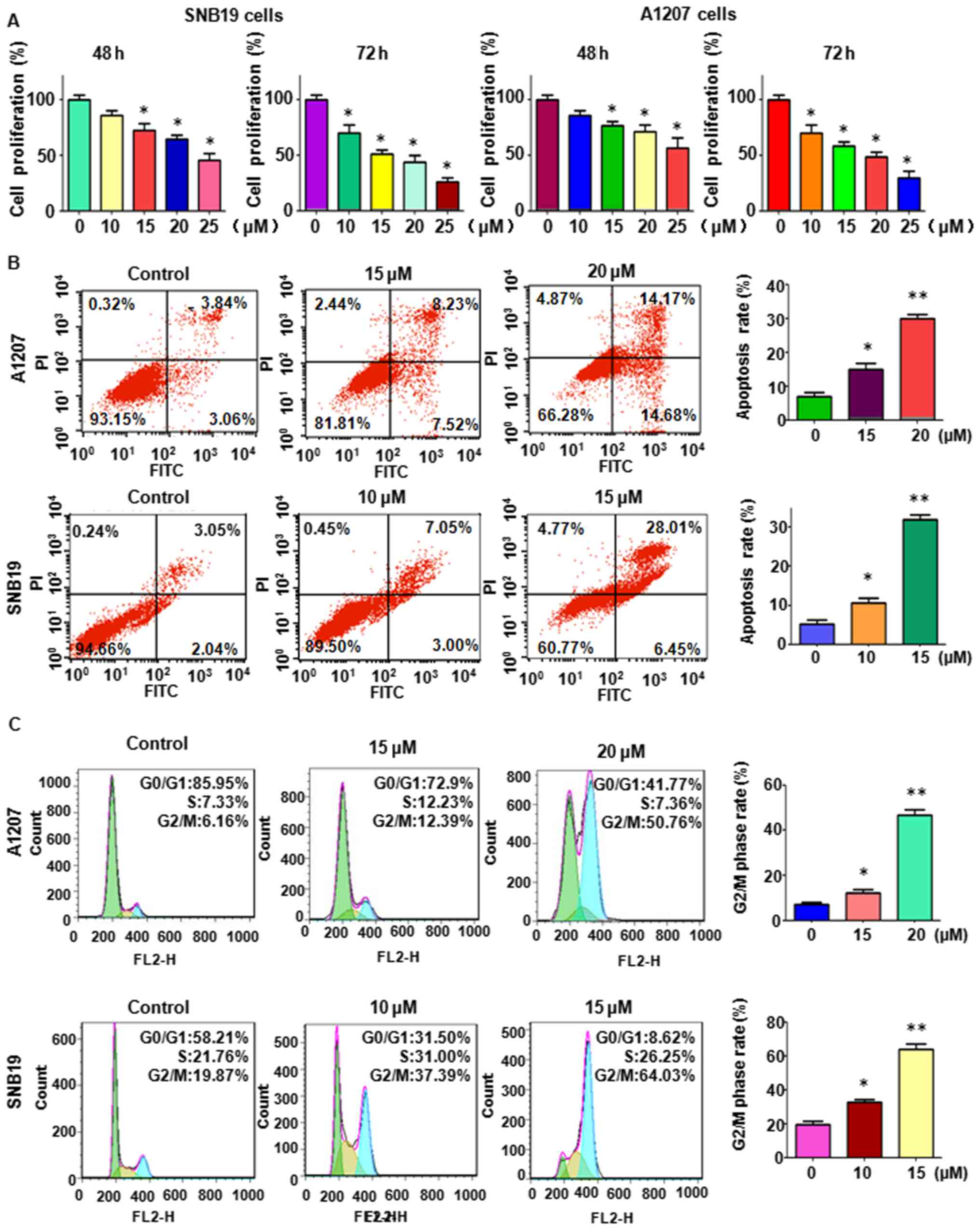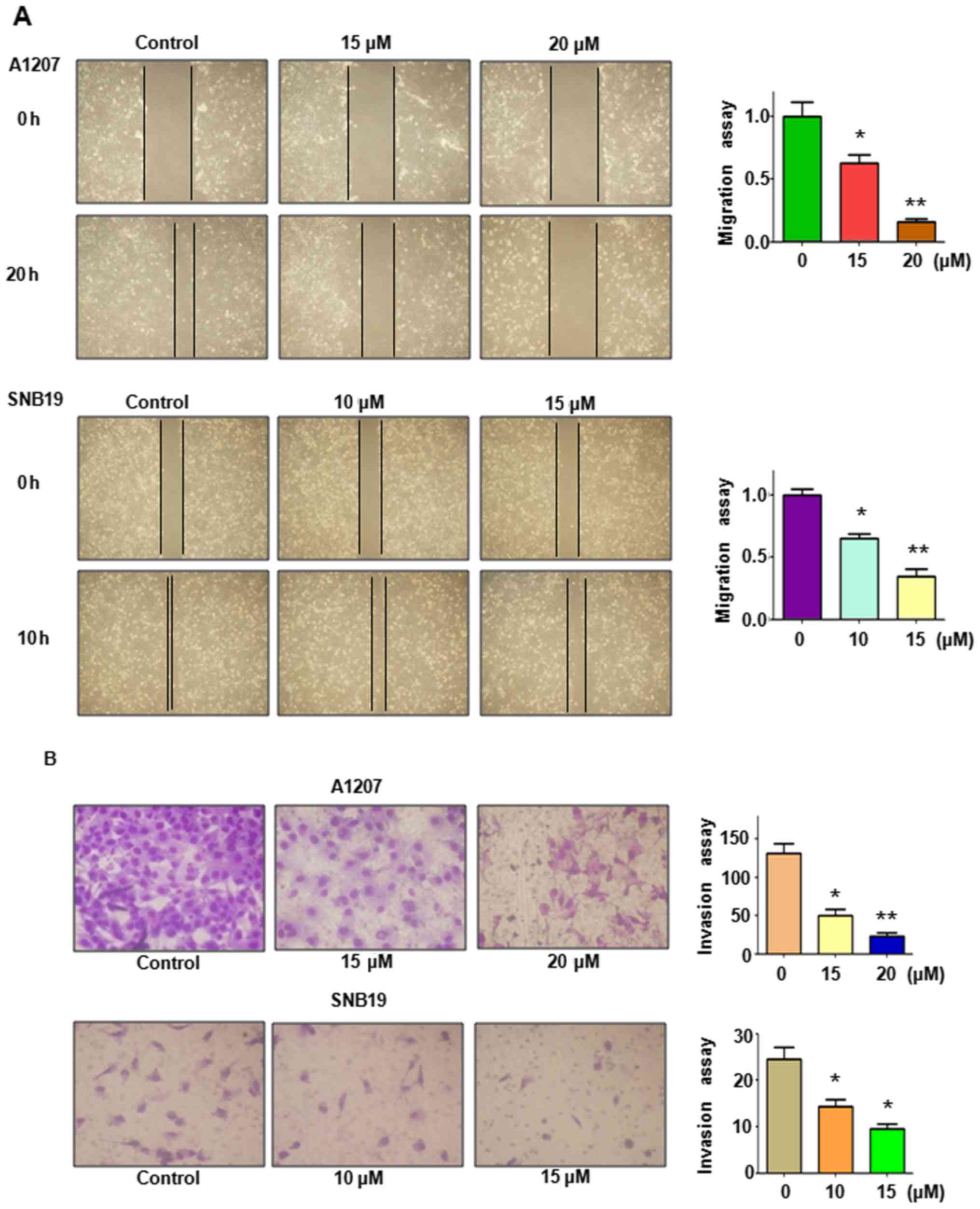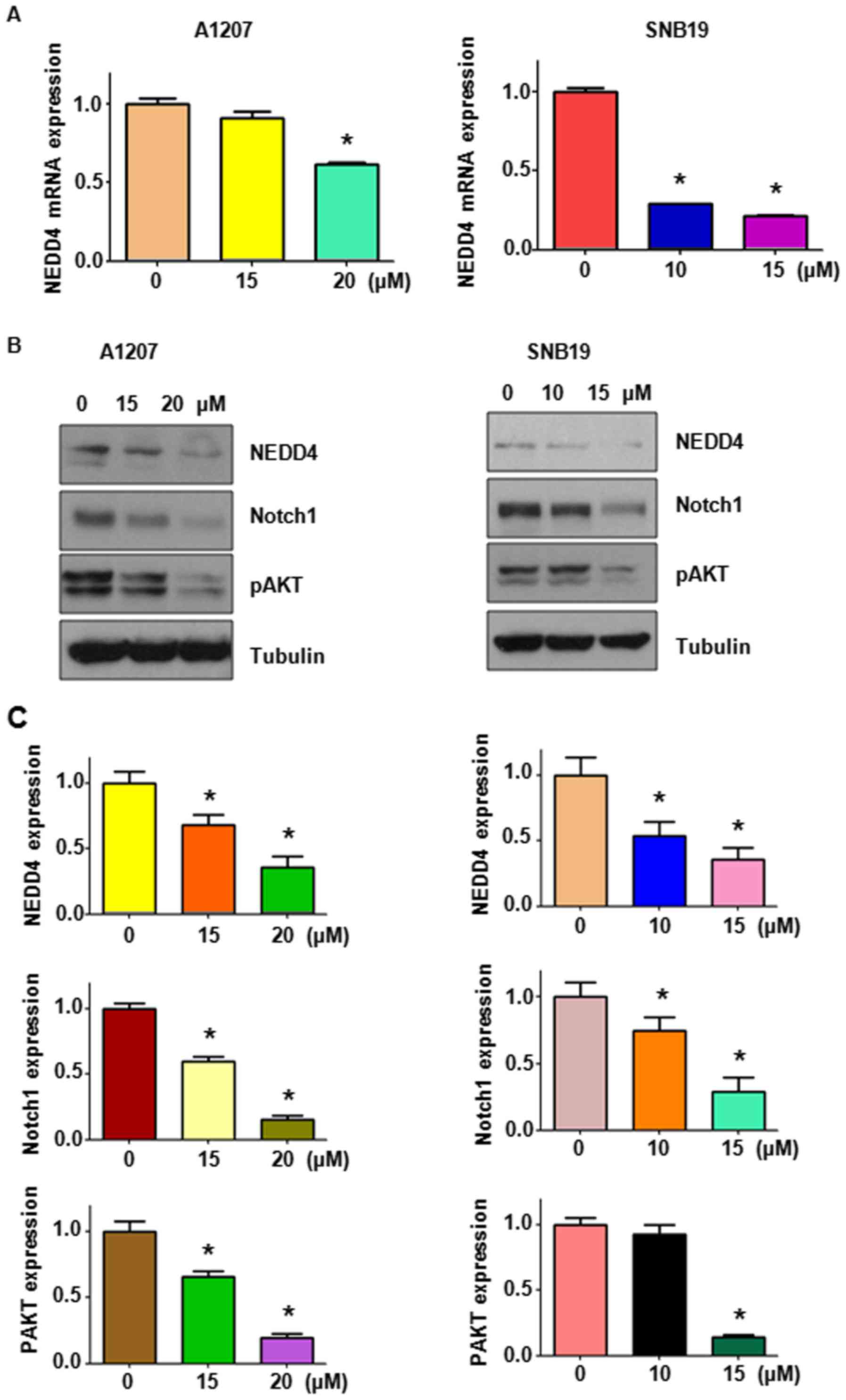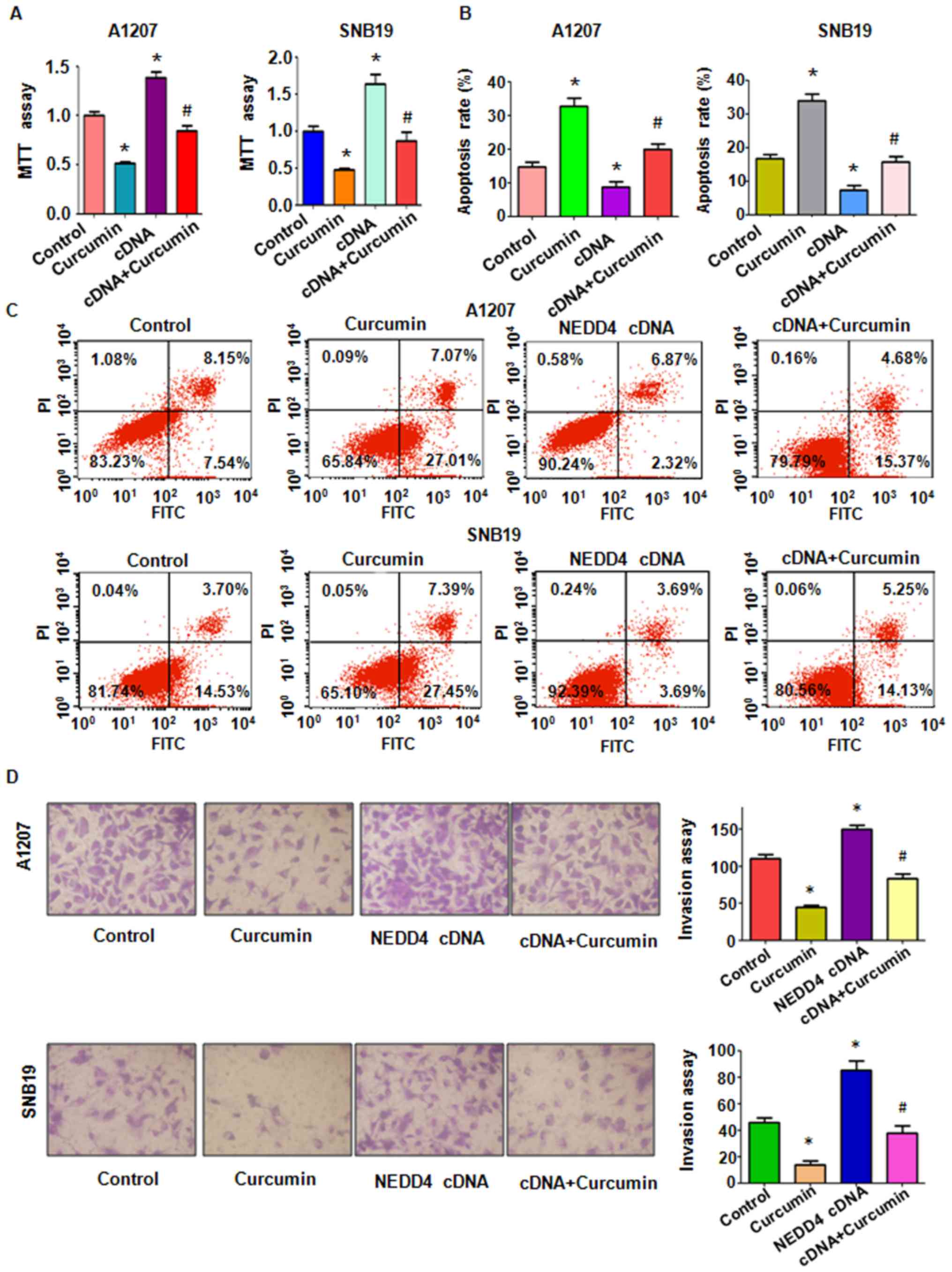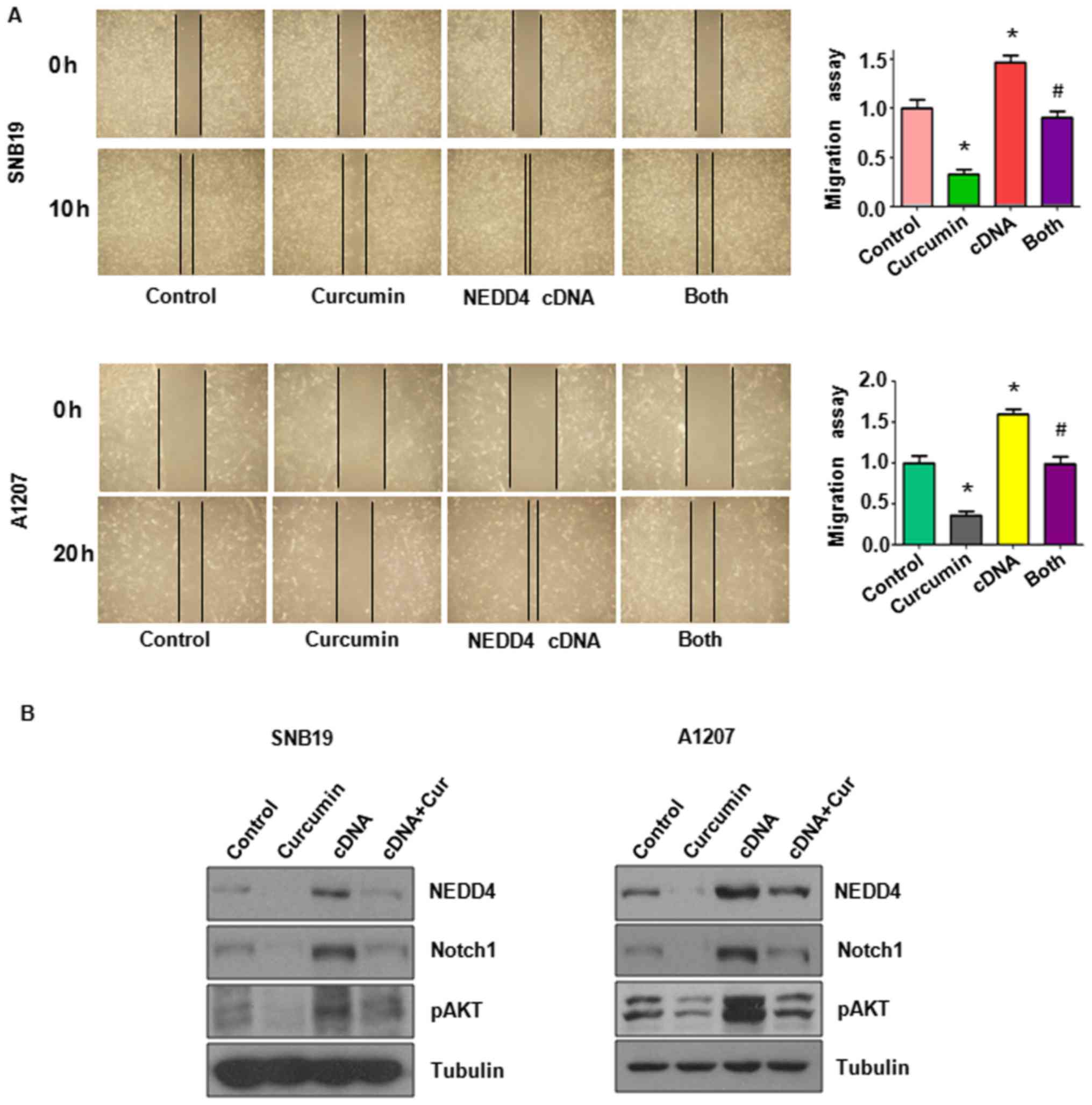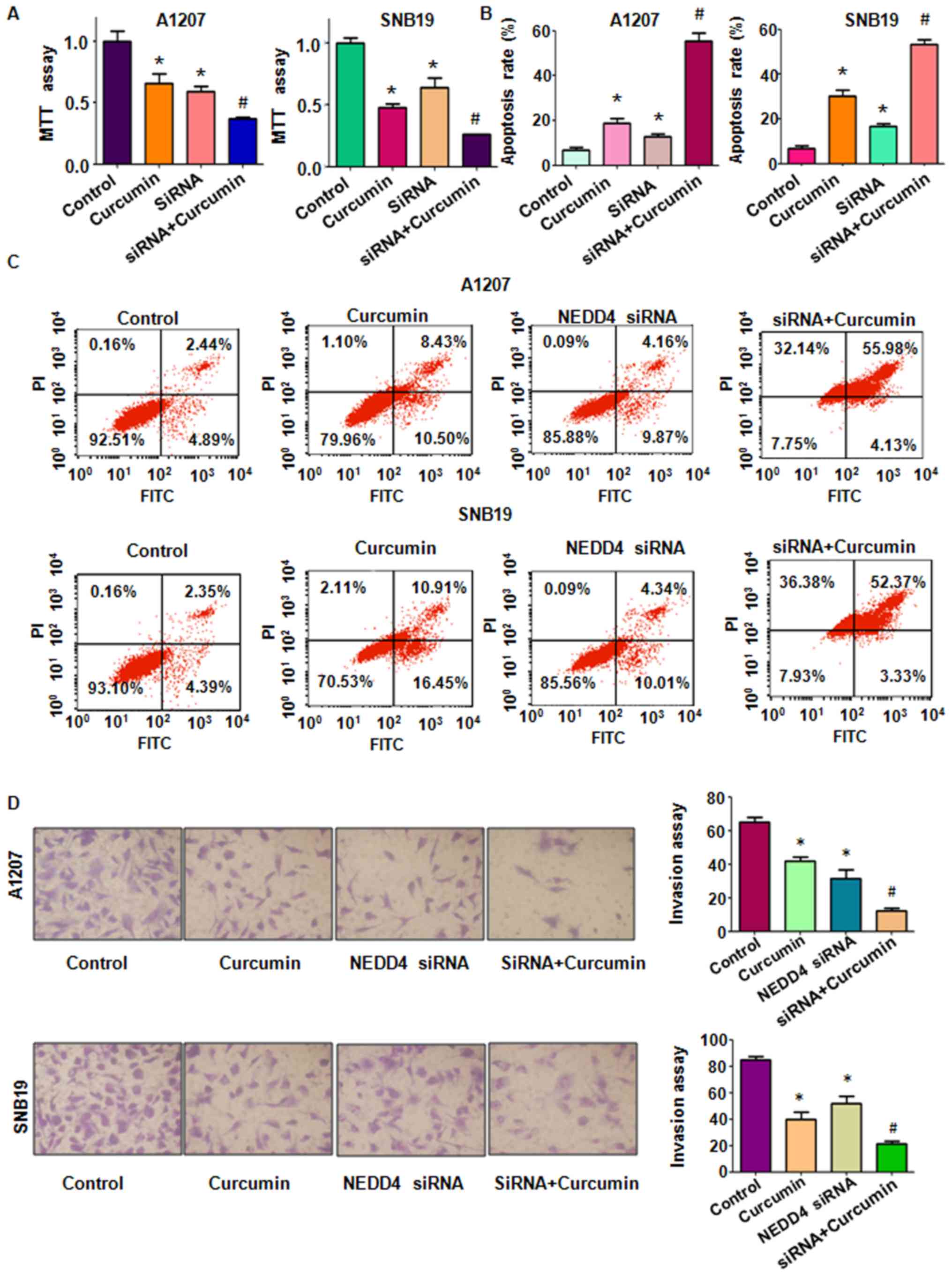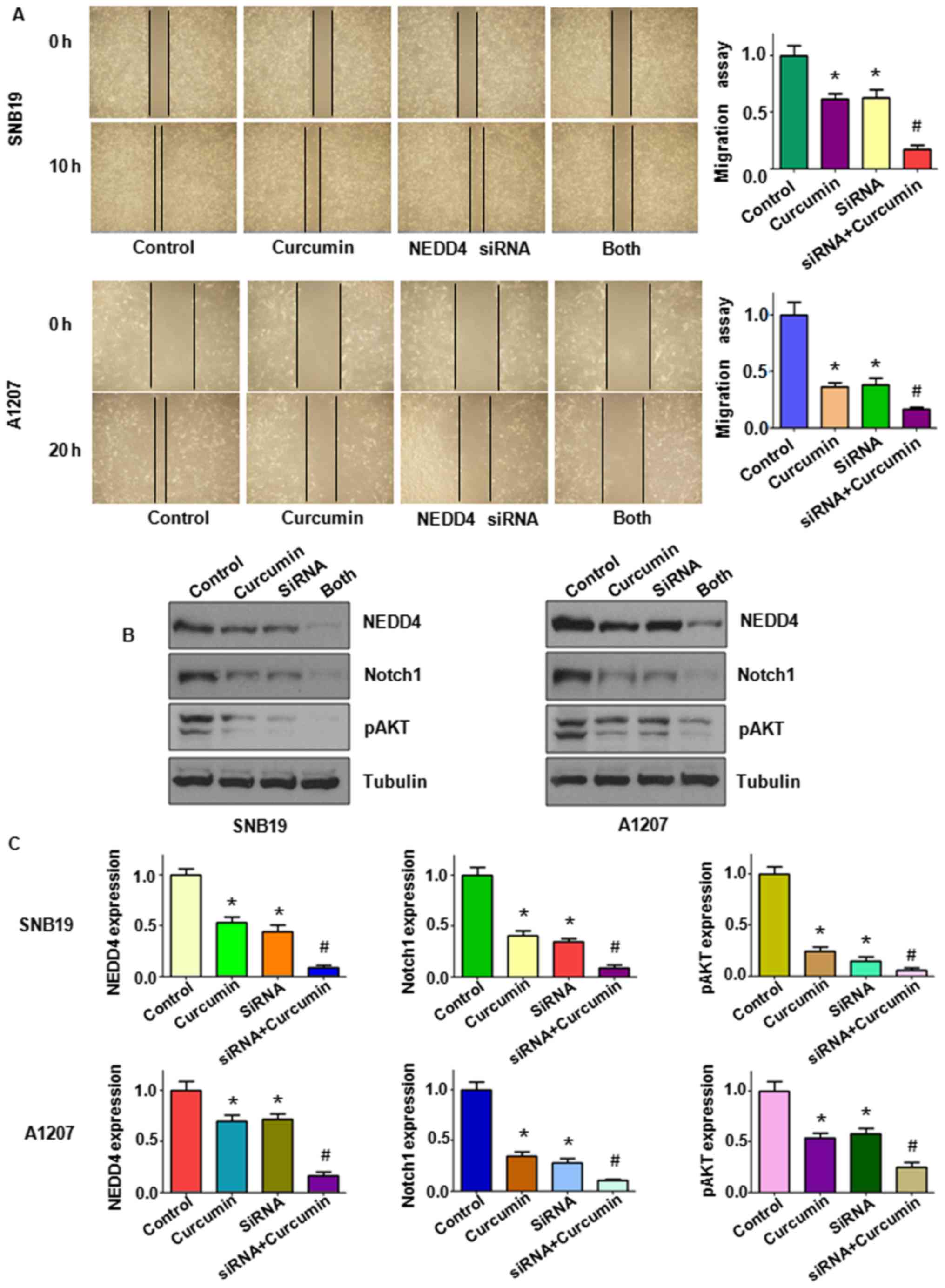|
1
|
Siegel RL, Miller KD and Jemal A: Cancer
statistics, 2016. CA Cancer J Clin. 66:7–30. 2016. View Article : Google Scholar : PubMed/NCBI
|
|
2
|
Aibaidula A, Lu JF, Wu JS, Zou HJ, Chen H,
Wang YQ, Qin ZY, Yao Y, Gong Y, Che XM, et al: Establishment and
maintenance of a standardized glioma tissue bank: Huashan
experience. Cell Tissue Bank. 16:271–281. 2015. View Article : Google Scholar
|
|
3
|
Mentlein R, Forstreuter F, Mehdorn HM and
Held-Feindt J: Functional significance of vascular endothelial
growth factor receptor expression on human glioma cells. J
Neurooncol. 67:9–18. 2004. View Article : Google Scholar : PubMed/NCBI
|
|
4
|
Kaur B, Khwaja FW, Severson EA, Matheny
SL, Brat DJ and Van Meir EG: Hypoxia and the
hypoxia-inducible-factor pathway in glioma growth and angiogenesis.
Neuro-oncol. 7:134–153. 2005. View Article : Google Scholar : PubMed/NCBI
|
|
5
|
Walbert T and Chasteen K: Palliative and
supportive care for glioma patients. Cancer Treat Res. 163:171–184.
2015. View Article : Google Scholar
|
|
6
|
Alifieris C and Trafalis DT: Glioblastoma
multiforme: pathogenesis and treatment. Pharmacol Ther. 152:63–82.
2015. View Article : Google Scholar : PubMed/NCBI
|
|
7
|
Singh S: From exotic spice to modern drug?
Cell. 130:765–768. 2007. View Article : Google Scholar : PubMed/NCBI
|
|
8
|
Sreedhar R, Arumugam S, Thandavarayan RA,
Karuppagounder V and Watanabe K: Curcumin as a therapeutic agent in
the chemo-prevention of inflammatory bowel disease. Drug Discov
Today. 21:843–849. 2016. View Article : Google Scholar : PubMed/NCBI
|
|
9
|
Aggarwal BB and Sung B: Pharmacological
basis for the role of curcumin in chronic diseases: An age-old
spice with modern targets. Trends Pharmacol Sci. 30:85–94. 2009.
View Article : Google Scholar
|
|
10
|
Rahmani AH, Al Zohairy MA, Aly SM and Khan
MA: Curcumin: A potential candidate in prevention of cancer via
modulation of molecular pathways. BioMed Res Int. 2014:7616082014.
View Article : Google Scholar : PubMed/NCBI
|
|
11
|
Kasi PD, Tamilselvam R, Skalicka-Wozniak
K, Nabavi SF, Daglia M, Bishayee A, Pazoki-Toroudi H and Nabavi SM:
Molecular targets of curcumin for cancer therapy: An updated
review. Tumour Biol. 37:13017–13028. 2016. View Article : Google Scholar : PubMed/NCBI
|
|
12
|
Bimonte S, Barbieri A, Leongito M,
Piccirillo M, Giudice A, Pivonello C, de Angelis C, Granata V,
Palaia R and Izzo F: Curcumin anticancer studies in pancreatic
cancer. Nutrients. 8:82016. View Article : Google Scholar
|
|
13
|
Zhao Z, Li C, Xi H, Gao Y and Xu D:
Curcumin induces apoptosis in pancreatic cancer cells through the
induction of forkhead box O1 and inhibition of the PI3K/Akt
pathway. Mol Med Rep. 12:5415–5422. 2015.PubMed/NCBI
|
|
14
|
Pattanayak R, Basak P, Sen S and
Bhattacharyya M: Interaction of KRAS G-quadruplex with natural
polyphenols: A spectroscopic analysis with molecular modeling. Int
J Biol Macromol. 89:228–237. 2016. View Article : Google Scholar : PubMed/NCBI
|
|
15
|
Bortel N, Armeanu-Ebinger S, Schmid E,
Kirchner B, Frank J, Kocher A, Schiborr C, Warmann S, Fuchs J and
Ellerkamp V: Effects of curcumin in pediatric epithelial liver
tumors: Inhibition of tumor growth and alpha-fetoprotein in vitro
and in vivo involving the NFkappaB- and the beta-catenin pathways.
Oncotarget. 6:40680–40691. 2015.PubMed/NCBI
|
|
16
|
Kasdagly M, Radhakrishnan S, Reddivari L,
Veeramachaneni DN and Vanamala J: Colon carcinogenesis: Influence
of Western diet-induced obesity and targeting stem cells using
dietary bioactive compounds. Nutrition. 30:1242–1256. 2014.
View Article : Google Scholar : PubMed/NCBI
|
|
17
|
Maspero E, Mari S, Valentini E, Musacchio
A, Fish A, Pasqualato S and Polo S: Structure of the HECT:ubiquitin
complex and its role in ubiquitin chain elongation. EMBO Rep.
12:342–349. 2011. View Article : Google Scholar : PubMed/NCBI
|
|
18
|
Zou X, Levy-Cohen G and Blank M: Molecular
functions of NEDD4 E3 ubiquitin ligases in cancer. Biochim Biophys
Acta. 1856:91–106. 2015.PubMed/NCBI
|
|
19
|
Liu Y, Oppenheim RW, Sugiura Y and Lin W:
Abnormal development of the neuromuscular junction in
Nedd4-deficient mice. Dev Biol. 330:153–166. 2009. View Article : Google Scholar : PubMed/NCBI
|
|
20
|
Moore G, Collins A, Brand C, Gold M,
Lethborg C, Murphy M, Sundararajan V and Philip J: Palliative and
supportive care needs of patients with high-grade glioma and their
carers: A systematic review of qualitative literature. Patient Educ
Couns. 91:141–153. 2013. View Article : Google Scholar
|
|
21
|
Lackovic J, Howitt J, Callaway JK, Silke
J, Bartlett P and Tan SS: Differential regulation of Nedd4
ubiquitin ligases and their adaptor protein Ndfip1 in a rat model
of ischemic stroke. Exp Neurol. 235:326–335. 2012. View Article : Google Scholar : PubMed/NCBI
|
|
22
|
Kwak YD, Wang B, Li JJ, Wang R, Deng Q,
Diao S, Chen Y, Xu R, Masliah E, Xu H, et al: Upregulation of the
E3 ligase NEDD4-1, by oxidative stress degrades IGF-1 receptor
protein in neurodegeneration. J Neurosci. 32:10971–10981. 2012.
View Article : Google Scholar : PubMed/NCBI
|
|
23
|
Amodio N, Scrima M, Palaia L, Salman AN,
Quintiero A, Franco R, Botti G, Pirozzi P, Rocco G, De Rosa N, et
al: Oncogenic role of the E3 ubiquitin ligase NEDD4-1, a PTEN
negative regulator, in non-small-cell lung carcinomas. Am J Pathol.
177:2622–2634. 2010. View Article : Google Scholar : PubMed/NCBI
|
|
24
|
Jung S, Li C, Jeong D, Lee S, Ohk J, Park
M, Han S, Duan J, Kim C, Yang Y, et al: Oncogenic function of
p34SEI-1 via NEDD4-1-mediated PTEN ubiquitination/degradation and
activation of the PI3K/AKT pathway. Int J Oncol. 43:1587–1595.
2013.PubMed/NCBI
|
|
25
|
Sun A, Yu G, Dou X, Yan X, Yang W and Lin
Q: Nedd4-1 is an exceptional prognostic biomarker for gastric
cardia adenocarcinoma and functionally associated with metastasis.
Mol Cancer. 13:2482014. View Article : Google Scholar : PubMed/NCBI
|
|
26
|
Hong SW, Moon JH, Kim JS, Shin JS, Jung
KA, Lee WK, Jeong SY, Hwang JJ, Lee SJ, Suh YA, et al: p34 is a
novel regulator of the oncogenic behavior of NEDD4-1 and PTEN. Cell
Death Differ. 21:146–160. 2014. View Article : Google Scholar
|
|
27
|
Wang X, Trotman LC, Koppie T, Alimonti A,
Chen Z, Gao Z, Wang J, Erdjument-Bromage H, Tempst P, Cordon-Cardo
C, et al: NEDD4-1 is a proto-oncogenic ubiquitin ligase for PTEN.
Cell. 128:129–139. 2007. View Article : Google Scholar : PubMed/NCBI
|
|
28
|
Dai B, Pieper RO, Li D, Wei P, Liu M, Woo
SY, Aldape KD, Sawaya R, Xie K and Huang S: FoxM1B regulates
NEDD4-1 expression, leading to cellular transformation and full
malignant phenotype in immortalized human astrocytes. Cancer Res.
70:2951–2961. 2010. View Article : Google Scholar : PubMed/NCBI
|
|
29
|
Zhang H, Nie W, Zhang X, Zhang G, Li Z, Wu
H, Shi Q, Chen Y, Ding Z and Zhou X: NEDD4-1 regulates migration
and invasion of glioma cells through CNrasGEF ubiquitination in
vitro. PLoS One. 8:e827892013. View Article : Google Scholar : PubMed/NCBI
|
|
30
|
Gupta SC, Kismali G and Aggarwal BB:
Curcumin, a component of turmeric: From farm to pharmacy.
Biofactors. 39:2–13. 2013. View Article : Google Scholar : PubMed/NCBI
|
|
31
|
Kang Y, Hu W, Bai E, Zheng H, Liu Z, Wu J,
Jin R, Zhao C and Liang G: Curcumin sensitizes human gastric cancer
cells to 5-fluorouracil through inhibition of the NFκB
survival-signaling pathway. Onco Targets Ther. 9:7373–7384. 2016.
View Article : Google Scholar :
|
|
32
|
Zhou X, Su J, Feng S, Wang L, Yin X, Yan J
and Wang Z: Antitumor activity of curcumin is involved in
down-regulation of YAP/TAZ expression in pancreatic cancer cells.
Oncotarget. 7:79076–79088. 2016.PubMed/NCBI
|
|
33
|
Zhang JR, Lu F, Lu T, Dong WH, Li P, Liu
N, Ma DX and Ji CY: Inactivation of FoxM1 transcription factor
contributes to curcumin-induced inhibition of survival,
angiogenesis, and chemosensitivity in acute myeloid leukemia cells.
J Mol Med (Berl). 92:1319–1330. 2014. View Article : Google Scholar
|
|
34
|
Lim SO, Li CW, Xia W, Cha JH, Chan LC, Wu
Y, Chang SS, Lin WC, Hsu JM, Hsu YH, et al: Deubiquitination and
stabilization of PD-L1 by CSN5. Cancer Cell. 30:925–939. 2016.
View Article : Google Scholar : PubMed/NCBI
|
|
35
|
Schönthal AH, Chen TC, Hofman FM, Louie SG
and Petasis NA: Preclinical development of novel anti-glioma drugs
targeting the endoplasmic reticulum stress response. Curr Pharm
Des. 17:2428–2438. 2011. View Article : Google Scholar : PubMed/NCBI
|
|
36
|
Perry MC, Demeule M, Régina A, Moumdjian R
and Béliveau R: Curcumin inhibits tumor growth and angiogenesis in
glioblastoma xenografts. Mol Nutr Food Res. 54:1192–1201.
2010.PubMed/NCBI
|
|
37
|
Sukumari-Ramesh S, Bentley JN, Laird MD,
Singh N, Vender JR and Dhandapani KM: Dietary phytochemicals induce
p53- and caspase-independent cell death in human neuroblastoma
cells. Int J Dev Neurosci. 29:701–710. 2011. View Article : Google Scholar : PubMed/NCBI
|
|
38
|
Purkayastha S, Berliner A, Fernando SS,
Ranasinghe B, Ray I, Tariq H and Banerjee P: Curcumin blocks brain
tumor formation. Brain Res. 1266:130–138. 2009. View Article : Google Scholar : PubMed/NCBI
|
|
39
|
Choi BH, Kim CG, Bae YS, Lim Y, Lee YH and
Shin SY: p21 Waf1/Cip1 expression by curcumin in U-87MG human
glioma cells: Role of early growth response-1 expression. Cancer
Res. 68:1369–1377. 2008. View Article : Google Scholar : PubMed/NCBI
|
|
40
|
Senft C, Polacin M, Priester M, Seifert V,
Kögel D and Weissenberger J: The nontoxic natural compound Curcumin
exerts anti-proliferative, anti-migratory, and anti-invasive
properties against malignant gliomas. BMC Cancer. 10:4912010.
View Article : Google Scholar : PubMed/NCBI
|
|
41
|
Wang L, Ye X, Cai X, Su J, Ma R, Yin X,
Zhou X, Li H and Wang Z: Curcumin suppresses cell growth and
invasion and induces apoptosis by down-regulation of Skp2 pathway
in glioma cells. Oncotarget. 6:18027–18037. 2015. View Article : Google Scholar : PubMed/NCBI
|
|
42
|
Du WZ, Feng Y, Wang XF, Piao XY, Cui YQ,
Chen LC, Lei XH, Sun X, Liu X, Wang HB, et al: Curcumin suppresses
malignant glioma cells growth and induces apoptosis by inhibition
of SHH/GLI1 signaling pathway in vitro and vivo. CNS Neurosci Ther.
19:926–936. 2013. View Article : Google Scholar : PubMed/NCBI
|
|
43
|
Yin S, Du W, Wang F, Han B, Cui Y, Yang D,
Chen H, Liu D, Liu X and Jiang C: MicroRNA-326 sensitizes human
glioblastoma cells to curcumin via the SHH/GLI1 signaling pathway.
Cancer Biol Ther. Nov 7–2016.Epub ahead of print. View Article : Google Scholar : PubMed/NCBI
|
|
44
|
Li D, Xu CY, Cui RJ, Tang JB, Sun H, Yang
ZK, Bu JY, Lin P, Huang N, Du YD, et al: DNA methylation inhibitor,
decitabine, promotes MGC803 gastric cancer cell migration and
invasion via the upregulation of NEDD4-1. Mol Med Rep.
12:8201–8208. 2015.PubMed/NCBI
|
|
45
|
Schiborr C, Kocher A, Behnam D, Jandasek
J, Toelstede S and Frank J: The oral bioavailability of curcumin
from micronized powder and liquid micelles is significantly
increased in healthy humans and differs between sexes. Mol Nutr
Food Res. 58:516–527. 2014. View Article : Google Scholar : PubMed/NCBI
|
|
46
|
Micel LN, Tentler JJ, Smith PG and
Eckhardt GS: Role of ubiquitin ligases and the proteasome in
oncogenesis: Novel targets for anticancer therapies. J Clin Oncol.
31:1231–1238. 2013. View Article : Google Scholar : PubMed/NCBI
|
|
47
|
Chen C and Matesic LE: The Nedd4-like
family of E3 ubiquitin ligases and cancer. Cancer Metastasis Rev.
26:587–604. 2007. View Article : Google Scholar : PubMed/NCBI
|
|
48
|
Mund T, Lewis MJ, Maslen S and Pelham HR:
Peptide and small molecule inhibitors of HECT-type ubiquitin
ligases. Proc Natl Acad Sci USA. 111:16736–16741. 2014. View Article : Google Scholar : PubMed/NCBI
|



